Youth correctional statistics in Canada, 2010/2011
Archived Content
Information identified as archived is provided for reference, research or recordkeeping purposes. It is not subject to the Government of Canada Web Standards and has not been altered or updated since it was archived. Please "contact us" to request a format other than those available.
By Christopher Munch
The article "Youth correctional statistics in Canada, 2010/2011" was updated October 12th, 2012. The changes affect data in Tables 2 and 4 and text on this page
- Rate of youth under correctional supervision decreases in 2010/2011
- British Columbia reports lowest rate of youth in the correctional system
- Rates for youth admitted to correctional services increase with age
- Aboriginal youth over-represented in the correctional system
- Youth incarceration rate declines for the third year in a row
- Crimes committed by youth admitted to sentenced custody tend to be non-violent
- Youth in remand outnumber those in sentenced custody for the fourth year in a row
- Most youth under community supervision are on probation
- Summary
- Data sources
- Detailed data tables
- References
- Notes
In Canada, the Youth Criminal Justice Act (YCJA), implemented in 2003, is the framework that guides correctional services for youth aged 12 to 17. The objectives of the YCJA are to improve decision-making in the youth justice system through the application of clear and coherent principles and to make more appropriate use of the courts to achieve fairness in sentencing. In addition, the YCJA aims to reduce the use of custody so that the most serious interventions are reserved for the most serious crimes, and to effectively reintegrate youth into the community (Department of Justice Canada 2011).
Using data from the Youth Custody and Community Services Survey, the youth component of the Integrated Correctional Services Survey and the Corrections Key Indicator Report for Young offenders, this Juristat article provides a statistical overview of youth admitted to and released from custody and community services in Canada. Analysis is presented at the national as well as the provincial and territorial levels. Average counts, admissions, and the characteristics of youth in the correctional system (such as age, sex and Aboriginal identity) are discussed.
This article uses two complementary measures to describe the use of correctional services for youth: average counts and admissions. Average counts provide a snapshot of the correctional population and are used to represent the number of youth in custody or under community supervision on any given day. Unless otherwise noted, rates of youth in the correctional system are based upon average counts. Admissions data, on the other hand, are collected each time an individual begins any type of custody or community program and are used to describe the characteristics of youth entering or moving between different types of correctional services. The same person can be included several times in the admission counts where the individual moves from one type of legal status to another (e.g., from remand to sentenced custody) or re-enters the system in the same year.
It is important to note that, in some years, there are certain provinces or territories that were unable to report complete data. Where applicable, gaps in reporting are noted accordingly.
Rate of youth under correctional supervision decreases in 2010/2011
On any given day in 2010/2011, there were about 14,800 youth (aged 12 to 17 at the time of the offence) in Canada's correctional system (excluding Quebec and youth under community supervision in Nova Scotia) (Table 1). This represented a rate of about 79 youth per 10,000 youth population, nearly 6% lower than the previous year,Note 1 and 12% lower than five years ago.Note 2
Youth in Canada's correctional system include those in custody as well as those who are supervised on a community sentence. As in previous years, most youth (90%)Note 3 in correctional services in 2010/2011 were under community supervision,Note 4 usually on probation. The decline in the overall rate of youth in correctional services since 2005/2006 was driven by decreases in both the rate of custody and community supervision, both down 12% (Chart 1).Note 5
Chart 1
Average counts of youth in correctional services, Canada, 2005/2006 to 2010/2011
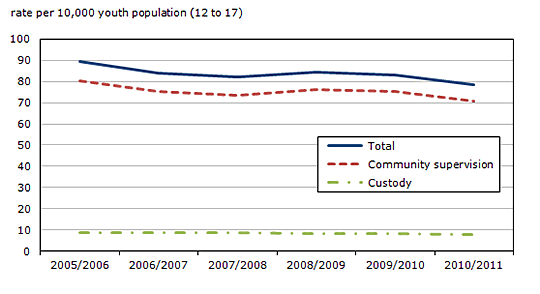
Note: Excludes data from Quebec as well as community supervision data from Prince Edward Island, Nova Scotia, and the Northwest Territories. Counts are based upon the average number of youth in correctional services at any given point in time. Rates are calculated per 10,000 youth population (12 to 17 years) using revised July 1st population estimates from Statistics Canada, Demography Division. Rates may not match those previously published in other reports.
Source: Statistics Canada, Canadian Centre for Justice Statistics, Corrections Key Indicator Report for Young Offenders.
One of the main factors that can influence the average daily count of youth in the correctional system is the rate of admissions. As stated previously, an admission is counted each time a person enters custody or a community supervision program. As such, the same person can be counted several times while moving from one type of legal status to another (e.g., from remand to sentenced custody to community supervision) or by re-entering the system in the same year.Note 6 Among the jurisdictions that reported admissions data in 2010/2011, there were a little over 43,600 youth admitted to correctional services, down 8% from 2005/2006 (Table 2).Note 7, Note 8
British Columbia reports lowest rate of youth in the correctional system
The rate of youth in the correctional system, on any given day, varies considerably across the country (Table 3). As has been the case for the past decade, the lowest rate of youth in the correctional system in 2010/2011 was in British Columbia, at 33 per 10,000 youth or less than half the overall average of 79.Note 9 In contrast, the highest rates were seen in the Northwest Territories (254), followed by Manitoba (205) (Chart 2).
Although the overall rate of youth in correctional services has declined over the past five years, not all jurisdictions reported a decline. More specifically, the rate in Yukon rose 38% between 2005/2006 and 2010/2011, Manitoba rose 17% and Alberta was up by 4%.
Chart 2
Average counts of youth in correctional services, by province and territory, 2010/2011
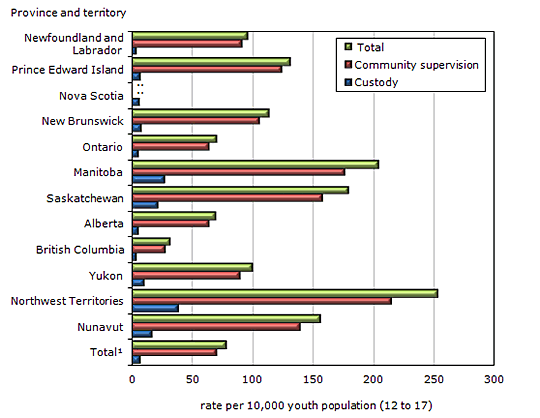
.. not available for a specific reference period
1. Excludes data from Quebec as well as community supervision data from Nova Scotia.
Note: Counts are based upon the average number of youth in community supervision at any given point in time. Rates are calculated per 10,000 youth population (12 to 17 years) using revised July 1st population estimates from Statistics Canada, Demography Division. Rates may not match those previously published in other reports.
Source: Statistics Canada, Canadian Centre for Justice Statistics, Corrections Key Indicator Report for Young Offenders.
Rates for youth admitted to correctional services increase with age
The rate of youth admitted to correctional services tends to increase with age, regardless of gender (Chart 3). More specifically, at 315 per 10,000 youth, the overall rate of 17-year-olds admitted to the correctional system in 2010/2011 was well above those for younger youth.Note 10, Note 11 The rate of male youth admitted to the correctional system increased with age, to a rate of 503 per 10,000 male youth in the population for 17-year-olds. The rate of female youth admitted to the correctional system increased with age until age 16, at 130 per 10,000 female youth population, but then decreased at age 17 to 119 per 10,000 female youth.
Males continued to account for the majority of youth admitted to correctional services. In 2010/2011, just over three quarters (78%) of youth admitted to the correctional system were male.Note 12
Chart 3
Youth admissions to correctional services, by age and gender, Canada, 2010/2011
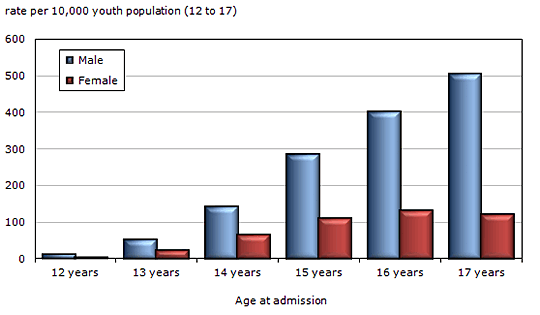
Note: Excludes data from Nova Scotia, Quebec, Saskatchewan, British Columbia, and Nunavut. Rates are calculated per 10,000 youth population (12 to 17 years) using revised July 1st population estimates from Statistics Canada, Demography Division. Based upon the age at admission. Excludes individuals whose age was unknown, and individuals 18 years of age or older who were 12 to 17 at the time the offence was committed. An admission is counted each time a person begins any type of custody or community program. The same person can be included several times in the admission counts where the individual moves from one type of legal status to another or re-enters the system in the same year.
Source: Statistics Canada, Canadian Centre for Justice Statistics, Youth Custody and Community Services Survey.
Aboriginal youth over-represented in the correctional system
When a youth is admitted to custody or community supervision, information on demographic characteristics, including Aboriginal identity, is gathered by intake officers. These admissions data show that, in 2010/2011, a disproportionate number of youth entering the correctional system were Aboriginal. Of the admissions recorded in 2010/2011 in the eight jurisdictions that provided data, just over one quarter (26%) was Aboriginal.Note 13 In comparison, about 6% of youth in these same jurisdictions are Aboriginal (Statistics Canada 2012).Note 14 The over-representation of Aboriginal youth in the correctional system held true across all reporting provinces and territories with the exception of Newfoundland and Labrador (Chart 4).
The disproportionate number of Aboriginal youth admitted to the correctional system was particularly true among females. In 2010/2011, Aboriginal female youth comprised 34% of all female youth in the correctional system, while Aboriginal male youth made up 24% of all male youth in the correctional system.Note 15 For both male and female youth in the general population, about 6% were Aboriginal (Statistics Canada 2012).Note 16
Chart 4
Aboriginal youth admissions to correctional services, by province and territory, 2010/2011
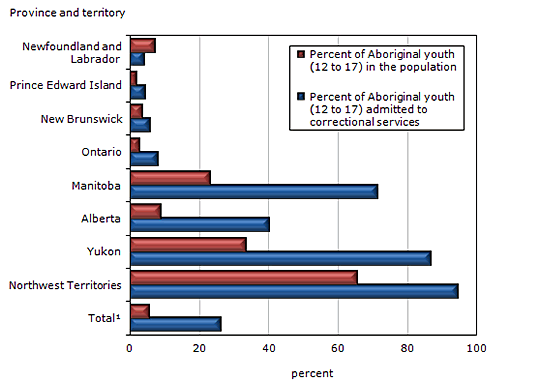
1. Excludes data from Nova Scotia, Quebec, Saskatchewan, British Columbia and Nunavut.
Note: Aboriginal youth refers to youth who reported identifying with at least one Aboriginal group, that is, North American Indian, Métis or Inuit, and/or those who reported being a Treaty Indian or a Registered Indian, as defined by the Indian Act of Canada, and/or those who reported they were members of an Indian band or First Nation. Excludes admissions to custody in which Aboriginal identity was unknown.
Source: Statistics Canada, Canadian Centre for Justice Statistics, Youth Custody and Community Services Survey.
Youth incarceration rate declines for the third year in a row
Canada's custodial population is composed of two main categories: sentenced custody and remand. Youth in sentenced custody include offenders found guilty of a crime and who are detained, either in open or secure custody. The extent to which custody is open or secure varies across jurisdictions. Open custody facilities can include community residential centres, group homes, childcare institutions, forest or wilderness camps, or separate sections within a secure facility. Remand is a type of court-ordered temporary detention for youth awaiting trial or sentencing.
Under the YCJA a youth can be sentenced to custody under certain circumstances, including the commission of a violent offence, failure to comply with the conditions of a community sentence, commission of an offence for which an adult would be liable to imprisonment for more than two years and a history that indicates a pattern of guilty findings. A youth can also be sentenced to custody in an exceptional case where the youth has committed an indictable offence and the aggravating circumstances are such that a non-custodial sentence would be inconsistent with the purposes and principles of sentencing (Department of Justice Canada 2011).
On any given day in 2010/2011, just over 1,500 youth, or about 10% of those in the correctional system, were in custody.Note 17 Of these, just over half (54%) were in remand and 44% were in sentenced custody. Of youth in sentenced custody, 53% were in secure custody, while 47% were in open custody.Note 18 The youth incarceration rate, at 8 per 10,000 youth population, fell 5% between 2009/2010 and 2010/2011, the third consecutive annual decline (Chart 1). The overall decrease in the rate of youth in custody between 2009/2010 and 2010/2011 was driven by decreases in youth in remand (-5%) as well as youth serving an open custody sentence (-7%) and youth serving a secure custody sentence (-3%) (Table 1).Note 19
Youth incarceration rates tend to vary across the country. In 2010/2011 the lowest rate, of 4 per 10,000 youth, was reported by British Columbia. The highest rates were reported in the Northwest Territories, at 39 per 10,000 youth population, followed by Manitoba, at 28 per 10,000 youth population (Table 4).
Over the past five years, youth incarceration rates have declined in most provinces and territories. The largest drop over this period was reported in Newfoundland and Labrador, down 58% between 2005/2006 and 2010/2011. There were, however, some exceptions to this trend, for example, Manitoba, which rose 38% during that time period.
Crimes committed by youth admitted to sentenced custody tend to be non-violent
In 2010/2011, seven provinces reported information to Statistics Canada in relation to the type of offence committed by youth admitted to sentenced custody.Note 20 Overall, six in ten (61%) crimes committed by youth admitted to sentenced custody in 2010/2011 were non-violent.Note 21 More specifically, 25% of admissions involved property offences, 16% involved other Criminal Code offences, and 19% involved other federal or provincial statute offences. The remaining 39% involved violent offences (Table 5). The main exceptions to this finding were in Manitoba and the Northwest Territories where most admissions to sentenced custody were for violent offences (80% and 62% respectively). In contrast, 15% of admissions to sentenced custody in New Brunswick were for violent offences.
Similar to previous years, periods of sentenced custody for youth were generally relatively short. Of the youth released from sentenced custody in 2010/2011, 41% served one month or less and another 49% served between one and six months (Chart 5). When comparing across provinces and territories, Yukon had the largest proportion of youth who served one month or less (79%), while New Brunswick had the smallest proportion (25%).
Chart 5
Time served by youth in sentenced custody, Canada, 2009/2010 and 2010/2011
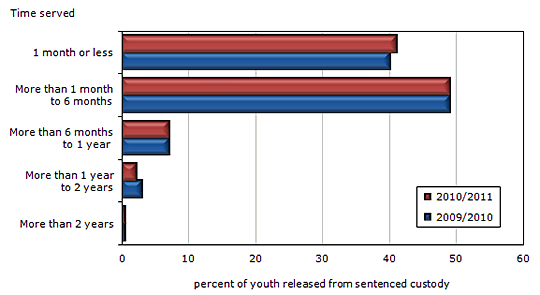
Note: Excludes data from Nova Scotia, Quebec, Saskatchewan, British Columbia and Nunavut.
Source: Statistics Canada, Canadian Centre for Justice Statistics, Youth Custody and Community Services Survey.
Youth in remand outnumber those in sentenced custody for the fourth year in a row
Youth may spend time in remand while awaiting trial or sentencing. When deciding whether to hold a youth in remand, a judge must consider provisions set out in the YCJA. First, remand may not be used as a substitute for child protection, mental health services, or other social measures. Second, a youth may not be detained if the youth could not be sentenced to custody for the accused offence. Lastly, a judge must inquire as to whether a responsible adult is available who would be willing to take care of and exercise control over the youth as an alternative to remand (Department of Justice 2011).
In 2010/2011, there were on average 820 youth in remand on any given day (Table 1), outnumbering those in sentenced custody for the fourth year in a row (Chart 6).Note 22 Manitoba had the highest rate of youth in remand at 19 youth per 10,000 youth population, almost five times higher than the overall rate of 4 per 10,000 youth.
Chart 6
Average counts of youth in remand and sentenced custody, Canada, 2005/2006 to 2010/2011
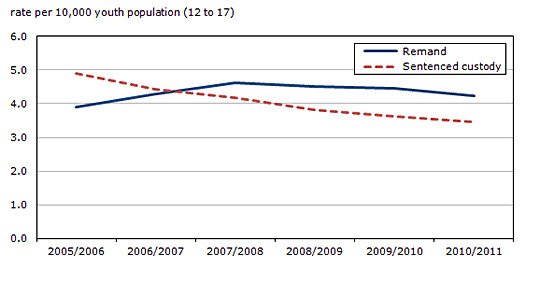
Note: Excludes data from Quebec. Rates are calculated per 10,000 youth population (12 to 17 years) using revised July 1st population estimates from Statistics Canada, Demography Division. Rates may not match those previously published in other reports.
Source: Statistics Canada, Canadian Centre for Justice Statistics, Corrections Key Indicator Report for Young Offenders.
In 2010/2011, over half (56%) of the youth released from remand spent less than one week in remand (Chart 7).Note 23 Another 25% spent between one week to one month in remand and 17% spent one to six months in remand. The remainder (2%) spent more than 6 months in remand. There were virtually no changes from 2009/2010.
Chart 7
Time spent by youth in remand, Canada, 2009/2010 and 2010/2011
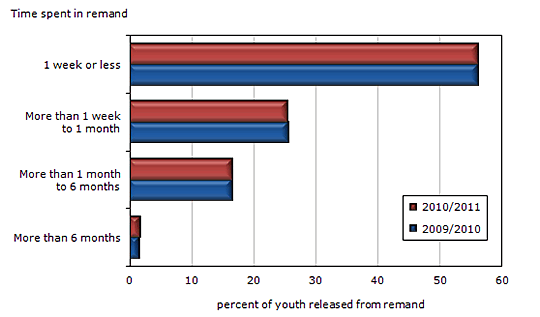
Note: Excludes data from Nova Scotia, Quebec, Saskatchewan, British Columbia and Nunavut. Excludes releases from remand for which the period of time spent was unknown.
Source: Statistics Canada, Canadian Centre for Justice Statistics, Youth Custody and Community Services Survey.
Of the youth who were released from remand in 2010/2011, those in the Northwest Territories spent the longest amount of time in remand. More specifically, the Northwest Territories had the lowest proportion of youth who served less than one week (19%) in remand, while almost half (46%) of youth in the Northwest Territories spent between one week and one month in remand. Among the provinces, Manitoba had the highest proportion of youth in remand who served between one and six months (26%).
Most youth under community supervision are on probation
Youth under community supervision include youth on probation, youth under an intensive support and supervision order, youth serving a deferred custody and supervision order, and youth serving the community portion of a custody and supervision order (Table 6). In 2010/2011, there were, on average, more than 13,300 youth under community supervision on any given day.Note 24 At 71 per 10,000 youth, the rate was 6% lower than the previous year and 12% lower than in 2005/2006.Note 25
The 2010/2011 rates of youth under community supervision were much higher than incarceration rates in all provinces and territories. British Columbia had the lowest rate of community supervision among youth, at 28 per 10,000 youth (Chart 8). In contrast, the Northwest Territories had the highest rate of community supervision among youth, at 215 per 10,000 youth population, followed by Manitoba at 177 youth per 10,000 youth population.
Chart 8
Average counts of youth under community supervision, by province and territory, 2010/2011
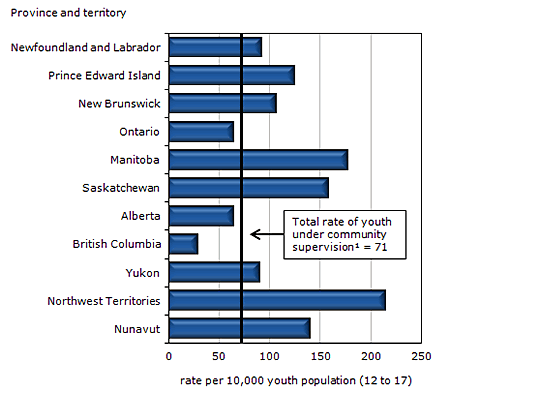
1. Excludes data from Nova Scotia and Quebec.
Note: Counts are based upon the average number of youth in community supervision at any given point in time. Rates are calculated per 10,000 youth population (12 to 17 years) using revised July 1st population estimates from Statistics Canada, Demography Division. Rates may not match those previously published in other reports.
Source: Statistics Canada, Canadian Centre for Justice Statistics, Corrections Key Indicator Report for Young Offenders.
As has continually been the case, the majority (91%) of youth under community supervision in 2010/2011 were on probation.Note 26 Youth on probation remain in the community and are subject to a number of conditions such as keeping the peace, residing at a particular address, and participating in rehabilitative programming (YCJA 2002). The median number of days youth were sentenced to probation was longest in Yukon at 420 days and the Northwest Territories at 382 days. (Chart 9).Note 27
Chart 9
Median number of days for youth sentenced to probation, by province and territory, 2010/2011
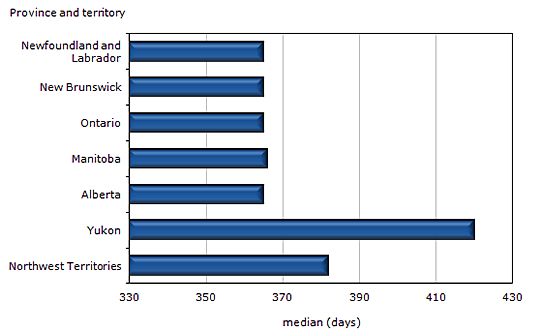
Note: Excludes data from Nova Scotia, Prince Edward Island, Quebec, Saskatchewan, British Columbia and Nunavut.
Source: Statistics Canada, Canadian Centre for Justice Statistics, Youth Custody and Community Services Survey.
Probation was the most common type of community supervision across all reporting provinces and territories, though to a lesser extent in British Columbia. British Columbia was the only jurisdiction to record a substantial proportion (39%) of youth under community supervision who were involved in intensive support and supervision programs (ISSP) introduced in the YCJA as an alternative to custody.Note 28 Like probation, ISSPs are served in the community under conditions, but provide closer monitoring and support than probation orders.
Text box 1
Status of youth on initial entry into correctional services
Information on youth in the correctional system is generally analysed using average counts or admissions data. However, another way to examine the involvement of youth in the correctional system is by looking at the legal status of individuals at the point of initial entry into the system. This method is similar to counting admissions, yet each person is only counted once regardless of a change in legal status.
In 2010/2011, data on the initial entry of youth into correctional services were available for six provinces and territories. In four of the six reporting jurisdictions (Newfoundland and Labrador, New Brunswick, Ontario, and the Northwest Territories), probation was the most common point of initial entry for youth. In the other two reporting jurisdictions, remand was the most common point of initial entry for youth in Manitoba, and other community supervision was the most common point of initial entry for youth in Yukon.
| Type of correctional service | Newfoundland and Labrador | New Brunswick | Ontario | Manitoba | Yukon | Northwest Territories |
|---|---|---|---|---|---|---|
| percent | ||||||
| Custody | 6.8 | 17.8 | 37.1 | 52.3 | 38.5 | 14.3 |
| Remand | 3.6 | 17.3 | 35.7 | 47.3 | 38.5 | 11.4 |
| Sentenced custody | 3.2 | 0.5 | 1.4 | 5.0 | 0.0 | 2.9 |
| Community supervision | 93.2 | 82.2 | 62.9 | 47.7 | 61.5 | 85.7 |
| Probation | 60.1 | 58.1 | 56.0 | 24.2 | 19.2 | 85.7 |
| Other community supervision | 33.1 | 24.1 | 6.8 | 23.5 | 42.3 | 0.0 |
| Total correctional services | 100.0 | 100.0 | 100.0 | 100.0 | 100.0 | 100.0 |
| Source: Statistics Canada, Canadian Centre for Justice Statistics, Integrated Correctional Services Survey. | ||||||
End of text box 1.
Summary
On any given day in 2010/2011, there were about 14,800 youth (aged 12 to 17 at the time their offence was committed) in Canada's correctional system (excluding Quebec and youth under community supervision in Nova Scotia). The rate of youth in corrections has been generally declining since 2005/2006, including a 6% drop between 2009/2010 and 2010/2011. The lowest rate of youth in correctional services in 2010/2011 was in British Columbia, at 33 per 10,000 youth, while the highest rate was in the Northwest Territories at 254 per 10,000 youth.
As in previous years, most (90%) youth in correctional services in 2010/2011 were under community supervision. On any given day, there were just over 13,300 youth serving a community supervision sentence in 2010/2011, 91% of whom were on probation. The remaining youth were serving an intensive support and supervision order, a deferred custody and supervision order, or a community portion of a custody and supervision order.
There were about 1,500 youth (10%) in custody on any given day (excluding Quebec). Of these, just over half were in remand (54%) and 44% were in sentenced custody. Of youth in sentenced custody, 53% were in secure custody, while 47% were in open custody.
Crimes committed by youth admitted to sentenced custody tend to be non-violent. More specifically, 61% of admissions involved property offences, other Criminal Code offences or other federal/provincial statute offences, while 39% involved violent offences. Youth in custody tended to be disproportionately Aboriginal.
Data sources
Data used in this article are drawn from three surveys conducted by Statistics Canada: the Youth Custody and Community Services Survey, the Integrated Correctional Services Survey and the Corrections Key Indicator Report (KIR) for Young offenders. The data are provided by the various provincial and territorial ministries and agencies that administer correctional services across the country. The surveys are conducted annually, on a fiscal-year (April to March) basis.
The Youth Custody and Community Services Survey (YCCS) collects data on the nature and case characteristics of youth admissions to correctional services. For trend data, the following omissions are noted: Prince Edward Island (2005/2006) Nova Scotia (2005/2006, 2009/2010, and 2010/2011), Saskatchewan (2005/2006, 2009/2010, and 2010/2011), British Columbia (2005/2006, 2009/2010, and 2010/2011) and Nunavut (2005/2006, 2009/2010, and 2010/2011). Also, youth characteristics related to sex, Aboriginal identity and age at admission were unavailable for the above provinces and territories as well as Quebec.
The Integrated Correctional Services Survey (ICSS) is a micro data survey, currently being implemented, and is intended to eventually replace the Youth Custody and Community Services Survey. The ICSS collects person-level descriptive data and characteristics information on youth offenders. Jurisdictions reporting youth correctional data to the ICSS include Newfoundland and Labrador, Nova Scotia, New Brunswick, Ontario, Alberta, and British Columbia.
The Corrections Key Indicator Report (KIR) for Young Offenders collects information used to calculate the average counts of youth in correctional services. Typically, correctional officials perform daily counts in their facilities and monthly counts of offenders under community supervision. Average count statistics, collected through the KIR, are more representative of youth serving longer term custody and community supervision sentences. They are also the count used to calculate incarceration rates. The following exclusions are noted for trend data: Prince Edward Island (2005/2006 for community data), Nova Scotia (2005/2006, 2009/2010, and 2010/2011 for community data), Quebec (2005/2006, 2009/2010, and 2010/2011), and the Northwest Territories (2005/2006 for community data).
Detailed data tables
Table 1 Average counts of youth in correctional services, Canada, 2010/2011
Table 3 Average counts of youth in correctional services, by province and territory, 2010/2011
Table 4 Average counts of youth in custody, by province and territory, 2010/2011
Table 6 Average counts of youth under community supervision, by province and territory, 2010/2011
References
Department of Justice Canada. 2011. The Youth Criminal Justice Act: Summary and Background. Ottawa. (accessed June 4, 2012).
Statistics Canada. 2012. Special tabulation, based on 2006 Census of Population.
Youth Criminal Justice Act (YCJA) , S.C. 2002. c. 1, Part 4 s.55(1) and s.55(2).
Notes
- Percent change in the rate from 2009/2010 to 2010/2011 for total correctional services excludes Nova Scotia and Quebec.
- Percent change in the rate from 2005/2006 to 2010/2011 for total correctional services excludes Prince Edward Island, Nova Scotia, Quebec, and the Northwest Territories.
- Proportion may be slightly under represented due to Nova Scotia only providing data for custody.
- Community supervision includes probation, community portion of custody and supervision order, deferred custody and supervision order, and intensive support and supervision programs.
- Excludes data from Quebec as well as community supervision data from Nova Scotia.
- Data published by Alberta's Ministry of the Solicitor General and Public Security are lower than the data published by Statistics Canada due to different counting methodologies. The numbers in Table 2 represent movement from one status in correctional services to another. For instance, an individual who moves from remand to sentenced custody is counted as one admission to remand and one admission to sentenced custody. Alberta uses a different methodology whereby an admission to custody is counted once, regardless of a change in status.
- The nine reporting jurisdictions were Newfoundland and Labrador, Prince Edward Island, New Brunswick, Quebec, Ontario, Manitoba, Alberta, Yukon, and the Northwest Territories.
- Percent change in rate from 2005/2006 to 2010/2011 for total correctional services excludes Prince Edward Island, Nova Scotia, Saskatchewan, British Columbia and Nunavut.
- See Note 5.
- Represents the age of the young person at the time of the admission. Excludes youth where the age was unknown. Excludes individuals 18 years of age or older who were 12 to 17 at the time the offence was committed.
- Excludes data from Nova Scotia, Quebec, Saskatchewan, British Columbia, and Nunavut.
- See Note 11.
- The eight reporting jurisdictions in 2010/2011 were Newfoundland and Labrador, Prince Edward Island, New Brunswick, Ontario, Alberta, Manitoba, Yukon and the Northwest Territories.
- Refers to youth who reported identifying with at least one Aboriginal group, that is, North American Indian, Métis or Inuit, and/or those who reported being a Treaty Indian or a Registered Indian, as defined by the Indian Act of Canada, and/or those who reported they were members of an Indian band or First Nation.
- Excludes data from Nova Scotia, Quebec, Saskatchewan, British Columbia and Nunavut.
- See Note 14.
- Includes a small percentage (about 1%) of youth serving Provincial Director Remand. Provincial Director Remand is used to hold a youth in custody following the breach of community supervision conditions or a custody and community supervision order pursuant to a warrant issued by the provincial director.
- Excludes data from Quebec.
- See Note 1.
- The seven reporting jurisdictions in 2010/2011 were Newfoundland and Labrador, Prince Edward Island, New Brunswick, Ontario, Manitoba, Yukon and the Northwest Territories.
- Admissions that involved more than one offence are represented by the most serious offence. Excludes admissions in which the most serious offence was unknown.
- See Note 18.
- Excludes data from Nova Scotia, Quebec, Saskatchewan, British Columbia and Nunavut. Excludes releases from remand for which the period of time spent was unknown.
- See Note 5.
- Percent change in rate from 2009/2010 to 2010/2011 for total correctional services excludes Nova Scotia and Quebec. Percent change in rate from 2005/2006 to 2010/2011 for total correctional services excludes Prince Edward Island, Nova Scotia, Quebec, and Northwest Territories.
- See Note 5.
- The seven reporting jurisdictions in 2010/2011 were Newfoundland and Labrador, New Brunswick, Ontario, Manitoba, Alberta, Yukon and the Northwest Territories. Time served refers to the aggregate time served or the total number of days a person spent upon completion of an uninterrupted period of time under a particular status.
- Each province and territory has the option of setting up intensive support and supervision programs (ISSP). In 2010/2011, ISSP were available in Newfoundland and Labrador, Ontario, Alberta, British Columbia, Yukon, and the Northwest Territories.
- Date modified:
